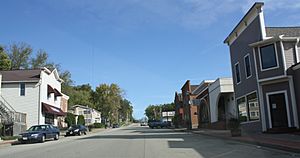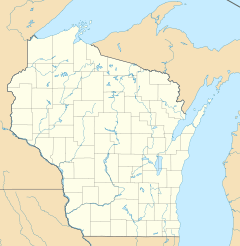Trempealeau, Wisconsin facts for kids
Quick facts for kids
Trempealeau, Wisconsin
|
|
|---|---|

Looking north at downtown Trempealeau
|
|

Location of Trempealeau in Trempealeau County, Wisconsin.
|
|
| Country | |
| State | |
| County | Trempealeau |
| Area | |
| • Total | 2.25 sq mi (5.84 km2) |
| • Land | 1.99 sq mi (5.14 km2) |
| • Water | 0.27 sq mi (0.70 km2) |
| Elevation | 738 ft (225 m) |
| Population
(2020)
|
|
| • Total | 1,843 |
| • Density | 928.5/sq mi (358.6/km2) |
| Time zone | UTC-6 (Central (CST)) |
| • Summer (DST) | UTC-5 (CDT) |
| Area code(s) | 608 |
| FIPS code | 55-80475 |
| GNIS feature ID | 1575590 |
Trempealeau (/ˈtrɛmpəloʊ/ trem-PƏ-loh) is a small village in Wisconsin, USA. It is located right along the Mississippi River in Trempealeau County. In 2020, about 1,843 people lived there. The village is surrounded by the larger Town of Trempealeau.
Contents
History of Trempealeau
Ancient Native American Life
Near Trempealeau, there is an old Native American site with special earth mounds. Scientists have been studying this area for many years. They think it might have been a mission or a small colony from Cahokia. Cahokia was a very important city of the Mississippian culture. It was located about 500 miles south, in what is now Illinois. The Mississippian culture thrived from about 1000 CE to 1450 CE.
Archeologists Danielle Benden and Robert Boszhardt have found proof of Mississippian people settling here around 1050 CE. These new settlers likely brought corn farming to the area. The archeology site is close to a famous landmark called Trempealeau Mountain. In 2013, more evidence was found. It showed that some buildings here were built in the Mississippian style. Some experts believe a religious group from Cahokia might have moved here. They may have been looking for a safe place to live.
European Settlement and Naming
Europeans did not settle in Trempealeau until the mid-1800s. However, French and English fur traders had been visiting the area for a long time. They traded with the Native American people living there. The first post office in Trempealeau opened in 1852. A French explorer gave the village its name. It was named after a nearby island in the Mississippi River.
Geography of Trempealeau
Trempealeau is located at 44°0′24″N 91°26′4″W / 44.00667°N 91.43444°W. The village covers a total area of about 2.25 square miles (5.84 square kilometers). Most of this area is land, about 1.99 square miles (5.14 square kilometers). The rest, about 0.27 square miles (0.70 square kilometers), is water.
Climate and Weather
Trempealeau has a varied climate. It experiences warm summers and cold winters. You can see more details about the weather in the chart below.
| Climate data for Trempealeau Dam 6, Wisconsin (1991–2020 normals, extremes 1937–present) | |||||||||||||
|---|---|---|---|---|---|---|---|---|---|---|---|---|---|
| Month | Jan | Feb | Mar | Apr | May | Jun | Jul | Aug | Sep | Oct | Nov | Dec | Year |
| Record high °F (°C) | 58 (14) |
62 (17) |
83 (28) |
93 (34) |
99 (37) |
103 (39) |
109 (43) |
108 (42) |
103 (39) |
91 (33) |
76 (24) |
65 (18) |
109 (43) |
| Mean daily maximum °F (°C) | 25.4 (−3.7) |
30.2 (−1.0) |
42.6 (5.9) |
57.2 (14.0) |
69.4 (20.8) |
78.3 (25.7) |
81.9 (27.7) |
79.7 (26.5) |
72.4 (22.4) |
59.1 (15.1) |
43.2 (6.2) |
30.3 (−0.9) |
55.8 (13.2) |
| Daily mean °F (°C) | 16.9 (−8.4) |
21.1 (−6.1) |
33.4 (0.8) |
46.9 (8.3) |
58.8 (14.9) |
68.4 (20.2) |
72.4 (22.4) |
70.2 (21.2) |
62.5 (16.9) |
49.7 (9.8) |
35.6 (2.0) |
23.0 (−5.0) |
46.6 (8.1) |
| Mean daily minimum °F (°C) | 8.5 (−13.1) |
12.1 (−11.1) |
24.2 (−4.3) |
36.7 (2.6) |
48.3 (9.1) |
58.5 (14.7) |
62.8 (17.1) |
60.7 (15.9) |
52.6 (11.4) |
40.4 (4.7) |
27.9 (−2.3) |
15.7 (−9.1) |
37.4 (3.0) |
| Record low °F (°C) | −44 (−42) |
−41 (−41) |
−32 (−36) |
8 (−13) |
24 (−4) |
35 (2) |
43 (6) |
40 (4) |
23 (−5) |
13 (−11) |
−9 (−23) |
−33 (−36) |
−44 (−42) |
| Average precipitation inches (mm) | 1.12 (28) |
1.14 (29) |
1.84 (47) |
3.68 (93) |
4.44 (113) |
4.31 (109) |
4.63 (118) |
4.09 (104) |
3.78 (96) |
2.59 (66) |
1.76 (45) |
1.33 (34) |
34.71 (882) |
| Average snowfall inches (cm) | 7.4 (19) |
10.1 (26) |
5.8 (15) |
1.7 (4.3) |
0.1 (0.25) |
0.0 (0.0) |
0.0 (0.0) |
0.0 (0.0) |
0.0 (0.0) |
0.0 (0.0) |
2.3 (5.8) |
8.8 (22) |
36.2 (92) |
| Average precipitation days (≥ 0.01 in) | 7.3 | 6.4 | 7.5 | 10.9 | 12.3 | 11.8 | 10.5 | 9.7 | 9.4 | 9.3 | 7.1 | 7.8 | 110.0 |
| Average snowy days (≥ 0.1 in) | 4.7 | 4.3 | 2.1 | 0.6 | 0.0 | 0.0 | 0.0 | 0.0 | 0.0 | 0.0 | 1.4 | 4.6 | 17.7 |
| Source: NOAA | |||||||||||||
Population of Trempealeau
The population of Trempealeau has grown over the years. Here is a quick look at how the number of people living in the village has changed.
| Historical population | |||
|---|---|---|---|
| Census | Pop. | %± | |
| 1880 | 615 | — | |
| 1900 | 609 | — | |
| 1910 | 535 | −12.2% | |
| 1920 | 536 | 0.2% | |
| 1930 | 541 | 0.9% | |
| 1940 | 527 | −2.6% | |
| 1950 | 645 | 22.4% | |
| 1960 | 704 | 9.1% | |
| 1970 | 743 | 5.5% | |
| 1980 | 956 | 28.7% | |
| 1990 | 1,039 | 8.7% | |
| 2000 | 1,319 | 26.9% | |
| 2010 | 1,529 | 15.9% | |
| 2020 | 1,843 | 20.5% | |
| U.S. Decennial Census | |||
Trempealeau in 2020
In 2020, the village had 1,843 residents. Most people living in Trempealeau were White (94%). There were also smaller groups of Asian, Black, and Native American residents. About 2% of the population identified as Hispanic or Latino.
The average income for a household in the village was about $56,383 per year. For families, it was around $67,500. A small number of families (2.7%) and people (4.1%) lived below the poverty line. This included some children and older adults. Most adults (98.3%) had finished high school or more. About 20.8% had a college degree or higher.
Trempealeau in 2010
In 2010, there were 1,529 people living in Trempealeau. There were 704 households, which are groups of people living together. About 27.3% of these households had children under 18. Many households (47.7%) were married couples.
The average age of people in the village was 42.7 years old. About 20.9% of residents were under 18. And 17.1% were 65 years old or older. The number of males and females was almost equal. About 49.8% were male and 50.2% were female.
Famous People from Trempealeau
Some notable people have come from Trempealeau:
- Gideon Winans Allen – He was a representative in the Wisconsin State government.
- Robert Grimes Coman – He was a Commodore in the U.S. Navy.
- Charles Kenneth Leith – He was a well-known geologist, a scientist who studies Earth's rocks and history.
- Todd Auer – He was a professional football player in the NFL.
Images for kids
-
Looking south at downtown Trempealeau, part of the Main Street Historic District, Mississippi River in background
-
Trempealeau Mountain at Perrot State Park
See also
 In Spanish: Trempealeau (Wisconsin) para niños
In Spanish: Trempealeau (Wisconsin) para niños












